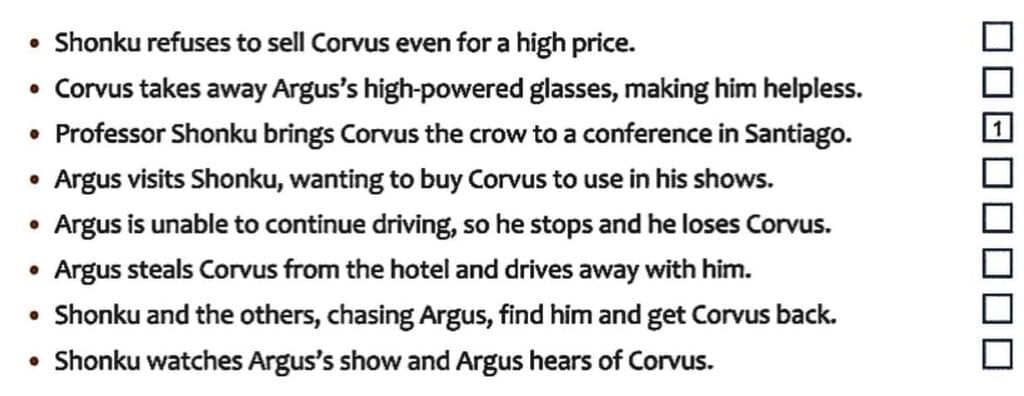Textbook Solutions: Corvus | Gul Mohar Class 6: Book Solutions, Summaries & Worksheets PDF Download
| Table of contents |

|
| Before You Read |

|
| While Reading |

|
| Understanding the Text |

|
| Appreciating the Text |

|
Before You Read
Think of a story or a film where an animal / bird-- plays an important part
- displays intelligence
- shares a close bond with a human being.
Write a few words in your notebook to describe –
- the bird/animal
- its relationship with the person.
Ans: Example: In Hachiko, a dog displays loyalty by waiting for his owner every day. The bond shows love, trust, and devotion.
While Reading
Q1. In para 5, how is Shonku treating Corvus?Ans: He treats Corvus with respect and affection, not forcing him to do anything, letting the bird act by choice.
Q2. What kind of atmosphere is created by the first two sentences of para 7?
Ans: A mysterious and suspenseful atmosphere, as the room goes dark except for a pale green light, creating a dramatic effect.
Q3. Note how this diary entry begins. What does it tell us about 15 November?
Ans: It begins by saying he could not write the previous night because of shock, which shows that 15 November was a tense, stressful day full of events.
Q4. Which word, used in para 13, means the same as cast his spell in para 21?
Ans: The word is “hypnotise.”
Q5. Why is Shonku worried about Corvus even though he knows the bird will be safe?
Ans: Shonku is worried about Corvus as he loves the bird deeply. Even though he knows Corvus will be safe, his affection and concern make him anxious, showing how much the bird means to him.
Q6. Did Corvus know how important Argus’s glasses were? How can you tell?
Ans: Yes, Corvus knew. He deliberately took Argus’s high-powered glasses, making him helpless, showing awareness of their importance.
Understanding the Text
A. Number these sentences in the correct order.
 Ans:
Ans:
- Professor Shonku brings Corvus the crow to a conference in Santiago. → 1
- Shonku watches Argus’s show and Argus hears of Corvus. → 2
- Argus visits Shonku, wanting to buy Corvus to use in his shows. → 3
- Shonku refuses to sell Corvus even for a high price. → 4
- Argus steals Corvus from the hotel and drives away with him. → 5
- Argus is unable to continue driving, so he stops and he loses Corvus. → 6
- Shonku and the others, chasing Argus, find him and get Corvus back. → 7
- Corvus takes away Argus’s high-powered glasses, making him helpless. → 8
B. Answer these questions.
Q1. “Corvus is not only my pupil; he is like a son to me, and a friend.” Find examples from the story that show Shonku loved and cared for Corvus.Ans: He let Corvus act freely, compared him to family, worried about his happiness, and felt relieved when he returned safely.
Q2. What would you say is the difference between how Shonku was using Corvus and how Argus wanted to use Corvus?
Ans: Shonku used Corvus for science and companionship, respecting him. Argus wanted to exploit him as a showpiece for fame and money.
Q3. “If it had been anyone else in my place, Argus would have accomplished his object … But Argus’s plan wouldn’t work with me.” What was Argus trying to do here? Was Shonku correct about both these remarks? Explain. (paras 12, 13 and 21)
Ans: Argus was trying to hypnotise Shonku. Yes, Shonku was correct: Argus often succeeded with others but failed with him because Shonku resisted.
Q4. “I realised his plight.” (para 31) What is Shonku referring to here? What had happened because of this ‘plight’? Who had caused this ‘plight’?
Ans: Shonku refers to Argus losing his glasses, leaving him helpless and shooting blindly. This plight was caused by Corvus, who cleverly took away the spectacles.
Q5. Give examples from the text to show that Corvus was indeed extraordinarily intelligent.
Ans: He switched off the lamp with accuracy, shut his cage door by himself, understood Argus’s weakness and took away his glasses, and returned calmly to Shonku at the end.
Appreciating the Text
Q1. Complete this paragraph.

Ans: This story is written in the first person, as Shonku, who is the speaker, is also a character in the story. It is written in the form of a diary. The two entries describe the events of two days and not just Shonku’s actions, but also his feelings and thoughts.
2. Which of these do you find in the story? Discuss in pairs.
Ans:
- a hero → Shonku
- a villain → Argus
- action → the chase, the theft, the gunfight
- adventure → journey with Corvus, danger from Argus
- crime → Argus stealing Corvus
- fantasy → a crow with human knowledge and intelligence
- good versus evil → Shonku’s honesty vs Argus’s greed
- happy ending → Corvus returns safely
- science fiction → machine transferring knowledge to a bird
- suspense → tension when Corvus was kidnapped
Ans: The most important elements are science fiction (knowledge transfer to a bird), suspense (kidnapping and chase), good vs evil (Shonku vs Argus), and happy ending (Corvus safe again).
|
30 videos|61 docs|17 tests
|
FAQs on Textbook Solutions: Corvus - Gul Mohar Class 6: Book Solutions, Summaries & Worksheets
| 1. What are the main themes explored in the article "Corvus"? |  |
| 2. Can you summarize the character development in "Corvus"? |  |
| 3. What literary devices are used in "Corvus" to enhance the narrative? |  |
| 4. How does the setting influence the plot of "Corvus"? |  |
| 5. What lessons can be learned from the story of "Corvus"? |  |














